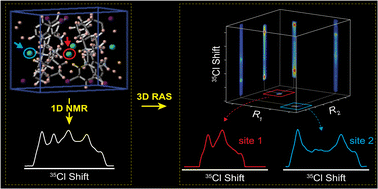3D relaxation-assisted separation of wideline solid-state NMR patterns for achieving site resolution†‡
Abstract
There are currently no methods for the acquisition of ultra-wideline (UW) solid-state NMR spectra under static conditions that enable reliable separation and resolution of overlapping powder patterns arising from magnetically distinct nuclei. This stands in contrast to the variety of techniques available for spin-1/2 or half-integer quadrupolar nuclei with narrow central transition patterns under magic-angle spinning (MAS). Resolution of overlapping signals is routinely achieved in MRI and solution-state NMR by exploiting relaxation differences between nonequivalent sites. Preliminary studies of relaxation assisted separation (RAS) for separating overlapping UWNMR patterns using pseudo-inverse Laplace Transforms have reported two-dimensional spectra featuring relaxation rates correlated to NMR interaction frequencies. However, RAS methods are inherently sensitive to experimental noise, and require that relaxation rates associated with overlapped patterns be significantly different from one another. Herein, principal component analysis (PCA) denoising is implemented to increase the signal-to-noise ratios of the relaxation datasets and RAS routines are stabilized with truncated singular value decomposition (TSVD) and elastic net (EN) regularization to resolve overlapped patterns with a larger tolerance for differences in relaxation rates. We extend these methods for improved pattern resolution by utilizing 3D frequency-R1–R2 correlation spectra. Synthetic and experimental datasets, including 35Cl (I = 3/2), 2H (I = 1), and 14N (I = 1) NMR of organic and biological compounds, are explored with both regularized 2D RAS and 3D RAS; comparison of these data reveal improved resolution in the latter case. These methods have great potential for separating overlapping powder patterns under both static and MAS conditions.



 Please wait while we load your content...
Please wait while we load your content...